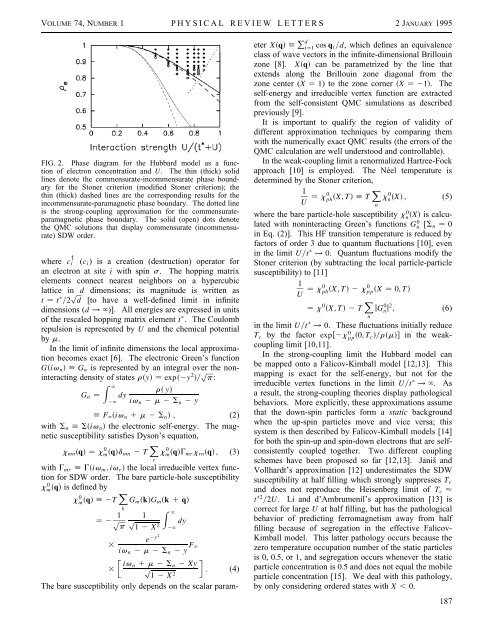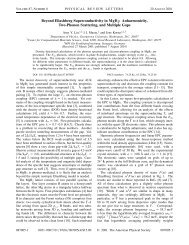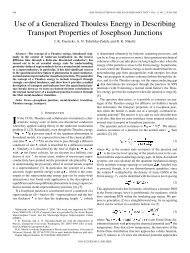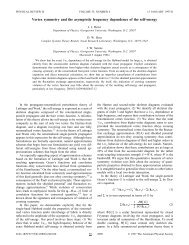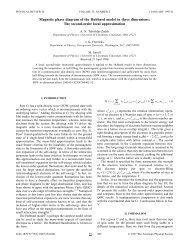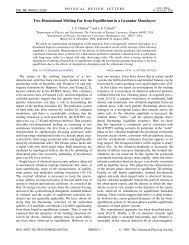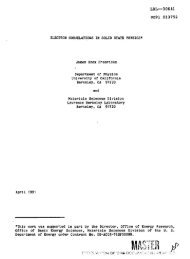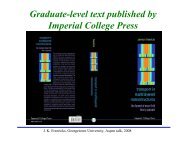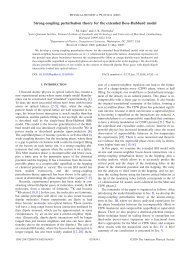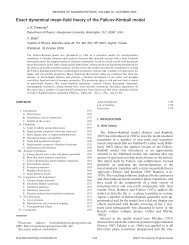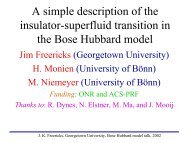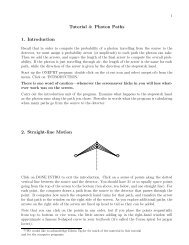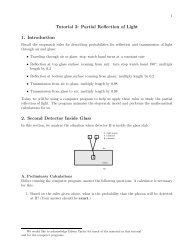Magnetic Phase Diagram of the Hubbard Model - Physics ...
Magnetic Phase Diagram of the Hubbard Model - Physics ...
Magnetic Phase Diagram of the Hubbard Model - Physics ...
You also want an ePaper? Increase the reach of your titles
YUMPU automatically turns print PDFs into web optimized ePapers that Google loves.
VOLUME 74, NUMBER 1 PHYSICAL REVIEW LETTERS 2JANUARY 1995<br />
FIG. 2. <strong>Phase</strong> diagram for <strong>the</strong> <strong>Hubbard</strong> model as a function<br />
<strong>of</strong> electron concentration and U. The thin (thick) solid<br />
lines denote <strong>the</strong> commensurate-incommensurate phase boundary<br />
for <strong>the</strong> Stoner criterion (modified Stoner criterion); <strong>the</strong><br />
thin (thick) dashed lines are <strong>the</strong> corresponding results for <strong>the</strong><br />
incommensurate-paramagnetic phase boundary. The dotted line<br />
is <strong>the</strong> strong-coupling approximation for <strong>the</strong> commensurateparamagnetic<br />
phase boundary. The solid (open) dots denote<br />
<strong>the</strong> QMC solutions that display commensurate (incommensurate)<br />
SDW order.<br />
where c y i (c i ) is a creation (destruction) operator for<br />
an electron at site i with spin s. The hopping matrix<br />
elements connect nearest neighbors on a hypercubic<br />
lattice in d dimensions; its magnitude is written as<br />
t t 2 p d [to have a well-defined limit in infinite<br />
dimensions (d ! `)]. All energies are expressed in units<br />
<strong>of</strong> <strong>the</strong> rescaled hopping matrix element t . The Coulomb<br />
repulsion is represented by U and <strong>the</strong> chemical potential<br />
by m.<br />
In <strong>the</strong> limit <strong>of</strong> infinite dimensions <strong>the</strong> local approximation<br />
becomes exact [6]. The electronic Green’s function<br />
Giv n G n is represented by an integral over <strong>the</strong> noninteracting<br />
density <strong>of</strong> states ry exp2y 2 p p:<br />
Z `<br />
G n <br />
r y<br />
dy<br />
2` iv n 2m2S n 2y<br />
F`iv n 1m2S n , (2)<br />
with S n Siv n <strong>the</strong> electronic self-energy. The magnetic<br />
susceptibility satisfies Dyson’s equation,<br />
x mn q xmqd 0 mn 2 T X xmqG 0 mr x rn q , (3)<br />
r<br />
with G mr Giv m , iv r <strong>the</strong> local irreducible vertex function<br />
for SDW order. The bare particle-hole susceptibility<br />
xmq 0 is defined by<br />
xm 0 q 2TX G m kG m k1q<br />
k<br />
2p 1 1<br />
Z `<br />
p dy<br />
p 12X<br />
2<br />
2`<br />
e 2y2<br />
3<br />
iv n 2m2S n 2y F`<br />
∑ ∏<br />
ivn 1m2S n 2Xy<br />
3 p . (4)<br />
1 2 X<br />
2<br />
The bare susceptibility only depends on <strong>the</strong> scalar parameter<br />
Xq P d<br />
i1cos q i d, which defines an equivalence<br />
class <strong>of</strong> wave vectors in <strong>the</strong> infinite-dimensional Brillouin<br />
zone [8]. Xq can be parametrized by <strong>the</strong> line that<br />
extends along <strong>the</strong> Brillouin zone diagonal from <strong>the</strong><br />
zone center (X 1) to <strong>the</strong> zone corner X 21. The<br />
self-energy and irreducible vertex function are extracted<br />
from <strong>the</strong> self-consistent QMC simulations as described<br />
previously [9].<br />
It is important to qualify <strong>the</strong> region <strong>of</strong> validity <strong>of</strong><br />
different approximation techniques by comparing <strong>the</strong>m<br />
with <strong>the</strong> numerically exact QMC results (<strong>the</strong> errors <strong>of</strong> <strong>the</strong><br />
QMC calculation are well understood and controllable).<br />
In <strong>the</strong> weak-coupling limit a renormalized Hartree-Fock<br />
approach [10] is employed.<br />
determined by <strong>the</strong> Stoner criterion,<br />
1<br />
U x0 ph X, T TX n<br />
The Néel temperature is<br />
xn 0 X, (5)<br />
where <strong>the</strong> bare particle-hole susceptibility xn 0 X is calculated<br />
with noninteracting Green’s functions Gn 0 [S n 0<br />
in Eq. (2)]. This HF transition temperature is reduced by<br />
factors <strong>of</strong> order 3 due to quantum fluctuations [10], even<br />
in <strong>the</strong> limit Ut ! 0. Quantum fluctuations modify <strong>the</strong><br />
Stoner criterion (by subtracting <strong>the</strong> local particle-particle<br />
susceptibility) to [11]<br />
1<br />
U x0 ph X, T 2x0 ppX 0, T<br />
X<br />
x 0 X, T 2 T jGn 0 j2 , (6)<br />
in <strong>the</strong> limit Ut ! 0. These fluctuations initially reduce<br />
T c by <strong>the</strong> factor exp2xpp 0 0, T crm in <strong>the</strong> weakcoupling<br />
limit [10,11].<br />
In <strong>the</strong> strong-coupling limit <strong>the</strong> <strong>Hubbard</strong> model can<br />
be mapped onto a Falicov-Kimball model [12,13]. This<br />
mapping is exact for <strong>the</strong> self-energy, but not for <strong>the</strong><br />
irreducible vertex functions in <strong>the</strong> limit Ut ! `. As<br />
a result, <strong>the</strong> strong-coupling <strong>the</strong>ories display pathological<br />
behaviors. More explicitly, <strong>the</strong>se approximations assume<br />
that <strong>the</strong> down-spin particles form a static background<br />
when <strong>the</strong> up-spin particles move and vice versa; this<br />
system is <strong>the</strong>n described by Falicov-Kimball models [14]<br />
for both <strong>the</strong> spin-up and spin-down electrons that are selfconsistently<br />
coupled toge<strong>the</strong>r. Two different coupling<br />
schemes have been proposed so far [12,13]. Janiš and<br />
Vollhardt’s approximation [12] underestimates <strong>the</strong> SDW<br />
susceptibility at half filling which strongly suppresses T c<br />
and does not reproduce <strong>the</strong> Heisenberg limit <strong>of</strong> T c <br />
t 2 2U. Li and d’Ambrumenil’s approximation [13] is<br />
correct for large U at half filling, but has <strong>the</strong> pathological<br />
behavior <strong>of</strong> predicting ferromagnetism away from half<br />
filling because <strong>of</strong> segregation in <strong>the</strong> effective Falicov-<br />
Kimball model. This latter pathology occurs because <strong>the</strong><br />
zero temperature occupation number <strong>of</strong> <strong>the</strong> static particles<br />
is 0, 0.5, or1, and segregation occurs whenever <strong>the</strong> static<br />
particle concentration is 0.5 and does not equal <strong>the</strong> mobile<br />
particle concentration [15]. We deal with this pathology,<br />
by only considering ordered states with X , 0.<br />
n<br />
187


